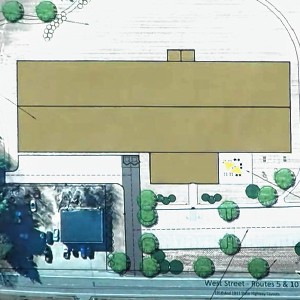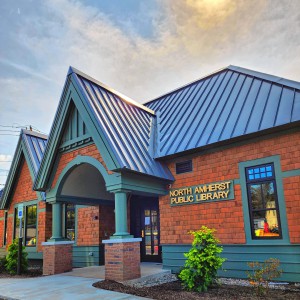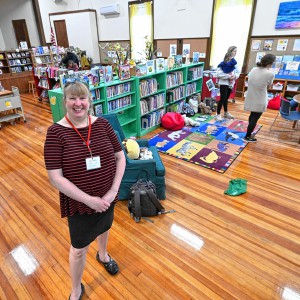Training for the worst case
| Published: 07-02-2017 9:58 AM |
AMHERST — A small section of a local school was on lockdown Monday as a principal stalked the halls, BB gun in hand.
He made his way past the dark green lockers and into two classrooms, where 13 adults were doing their best to hide. He walked up to the 11 cowering targets that were readily visible, and one by one shot them all.
It was a just drill, but the tension in the air at Amherst Regional Middle School was unmistakable.
“Not a comfortable feeling,” Crocker Farm Elementary Principal Derek Shea said, seemingly shaken by the experience of playing a violent intruder in the exercise.
The scenario, meant to simulate a traditional lockdown, was part of a training put on by the ALICE Training Institute, a company that conducts active-shooter trainings for schools, police departments, businesses and other organizations that put forward strategies to improve the chances of survival when a shooter attacks.
As the horror of mass shootings continues to haunt the country’s collective conscience, ALICE and others have been promoting more proactive approaches to active-shooter situations. Their methods, which include suggestions to quickly evacuate or deploy counter maneuvers against shooters, in some ways resemble harm reduction policies — seeking to limit the negative consequences of a human behavior that shows no signs of slowing down.
Those policies represent an evolving understanding of best practices when a shooter starts firing rounds. The Department of Homeland Security has since at least 2008 urged people to “run, hide, fight” when they encounter a shooter. After the 2012 shooting at Sandy Hook Elementary School in Newtown, Connecticut, six federal agencies worked together for the first time to develop proven emergency management practices. That report, released in 2013, also lays out the “three basic options” during an active-shooter scenario as “run, hide, or fight.”
That too was more or less the message on Monday, when 14 officials from local police departments, schools, a business, Jones Library and other institutions gathered to hear about the methods proposed by ALICE, an acronym that stands for Alert, Lockdown, Inform, Counter and Evacuate.
Article continues after...
Yesterday's Most Read Articles
 Northampton bans auto dealerships near downtown; zone change won’t affect Volvo operation on King Street
Northampton bans auto dealerships near downtown; zone change won’t affect Volvo operation on King Street
 Proposed Hatfield pickleball/tennis building raising eyebrows
Proposed Hatfield pickleball/tennis building raising eyebrows
 South Hadley man killed in I-91 crash
South Hadley man killed in I-91 crash
 ‘Home away from home’: North Amherst Library officially dedicated, as anonymous donor of $1.7M revealed
‘Home away from home’: North Amherst Library officially dedicated, as anonymous donor of $1.7M revealed
 Police respond to alcohol-fueled incidents in Amherst
Police respond to alcohol-fueled incidents in Amherst
 Public gets a look at progress on Northampton Resilience Hub
Public gets a look at progress on Northampton Resilience Hub
“We’re teaching people common sense tactics,” Sean Kennedy, a national ALICE trainer, told the Gazette. “It’s just not common knowledge.”
Those tactics are a departure from the lone response that so many institutions have put in place in the past: close and lock the doors, turn the lights out and hide out of view.
“People were used to so many years of that single mandated response — lockdown,” Kennedy said. Now, however, he said people are beginning to come around to methods like the ones ALICE advocates. “Over the last five, six years it has really started to take off.”
To demonstrate how traditional methods like passive lockdown protocols can be insufficient, Kennedy played the 911 call from Patti Nielson, who was a teacher at Columbine High School when a 1999 school shooting there left 15 dead and 24 injured.
For more than four minutes, Nielson talked with emergency dispatchers, telling them that she had instructed students to lie under tables in the library. Although there was an easily accessible exit nearby, the 52 students and four staff members remained hiding while the two killers lingered right outside in the hallway. The assailants eventually entered the library, where they killed 10 and wounded 12.
“That library should have been empty, but you can’t fault Patti Nielson,” Kennedy said. “They were never empowered to leave, they were never given that option.”
The BB gun exercise with Shea, the principal, was meant to demonstrate the futility of those types of passive lockdowns. Shea had never fired a handgun, and yet despite his lack of basic skills with firearms was nevertheless able to effortlessly shoot 11 of the 13 participants hiding from him.
In the second exercise, Kennedy instead chose one of the most tactically advanced participants — Sgt. David Rice of the Greenfield Police Department. The 13 others were placed in several classrooms, but this time were given instructions to evacuate the building when the active-shooter warning was sounded.
Despite Rice’s marksmanship and tactical training, he was unable to hit any of the would-be victims fleeing down the hall away from him, and failed to see others sneaking out of doors behind his back.
“It’s all about movement,” Kennedy said. Any action that decreases a shooter’s ability to accurately and consistently hit targets will ultimately save lives, the thinking goes.
Of course, there are scenarios when it would not be possible to flee. In cases when a stay-in-place lockdown is necessary, Kennedy encouraged barricading doors, as well as other counter maneuvers like simply moving around.
In the third BB gun exercise, participants sat at desks in a classroom when the intruder suddenly burst through the door. Unbeknownst to the shooter, however, Kennedy had given red foam balls to each of the participants, instructing them to throw them at the shooter before swarming him, grabbing his arms and legs.
Again, zero participants were shot before the shooter was subdued.
“You have to turn their action into reaction,” he said. Anything to distract a shooter, lower his accuracy, put him off balance or on the defensive is better than simply doing nothing, according to Kennedy.
Unlike the phrase that federal agencies use — “run, hide, fight” — ALICE prefers to use the word “counter” rather than “fight.”
“We’re not teaching people to run toward gunfire to fight an armed gunman,” he said. Instead, the idea is to empower people to make any decision that might increase their survivability.
“I think what’s really important about this is it’s research-based,” Amherst Regional Middle School Principal Patty Bode said. “Unfortunately, we have a lot of data.”
Staff at Amherst Regional High School completed an ALICE training last year, and the school will host meetings with parents this fall to begin discussions about implementing the new protocols, according to interim Superintendent Michael Morris. After evaluating the implementation of ALICE protocols at the high school, he said, the district will consider putting them in place at the middle and elementary school level, where the onus of deploying evacuations or countermeasures falls more on educators given the children’s young ages.
Amherst’s decision to go through an ALICE training comes after then-Gov. Deval Patrick put together a school safety and security task force in 2014 that specifically referenced ALICE when suggesting appropriate emergency preparations.
“Depending on the situation, there are several ways to enhance a lockdown to empower individuals to take common sense actions critical to their safety,” the report said. “These may include: 1) barricading the door using available furniture and other objects; 2) distracting or countering the assailant, and 3) self-evacuation.”
Those lessons have trickled down to some other districts, even if they don’t explicitly train staff to counter an assailant.
“When we’re in that type of situation, educators are aware to use any means necessary to protect our kids,” said Andrew Berrios, principal at Hatfield’s Smith Academy. At a previous lockdown exercise, he said, one teacher even had a brick in hand.
Not every school district, however, implements those “fight” or “counter” aspects of ALICE, which some believe might be ill-advised.
Northampton school resource officer Joshua Wallace is part of the region’s safe schools task force, which is run out of the state police barracks in Northampton and oversees “enhanced lockdown” trainings for a large number of schools across the western part of the state.
“It’s built off of ALICE, it just doesn’t have the confrontation aspect built into it,” Wallace said of enhanced lockdowns. “We don’t teach that.”
Instead, the task force trains staff to shut blinds, turn off any source of light, shut the doors and cover any windows looking in. Students are placed away from doors and windows, with a teacher standing between them and where an attacker might enter. Staff are encouraged to barricade doors, and to evacuate students, but only if there’s a readily accessible and obviously safe exit nearby.
The idea, he said, is to buy time for trained law enforcement to show up. He described the “counter” portion of ALICE as asking staff to beat back an attacker — a task that only law enforcement are properly trained to do.
“You’re going after someone with a gun with a can of soup,” he quipped. “That’s pretty aggressive.”
Wallace said that law enforcement officials differ in their opinions on the subject, and often discuss best practices.
“I don’t think either one is better,” he added. “I think both of them have their purposes.”
But regardless of the different tactics, Wallace said he has undoubtedly seen an evolution in how law enforcement and potentially vulnerable institutions approach active-shooter situations.
“The thought behind it all definitely has changed,” he said. “We have become definitely more proactive.”
The day’s last exercise at the ALICE training in Amherst was largely focused on debunking the notion that giving guns to the “good guys” — in other words, arming teachers — is a successful strategy to combat active shooter situations.
In this scenario, Rice, the Greenfield sergeant, was put in front of the room to act as a teacher and was given a BB gun to hold in his hand. Expecting to shoot at an intruder coming through the door, he was unaware that one of his “pupils” in the classroom was also armed with a BB gun.
As Rice stood at the front of the classroom, distracted as Kennedy explained the drill, one of the participants casually walked over, picked up a BB gun from the nearby table and shot him.
The situation isn’t an unrealistic one. Kennedy pointed to a January shooting at a private school near Monterrey, Mexico, where a teenage student brought a gun into the classroom, killing an unexpecting teacher and two classmates before turning the weapon on himself.
Kennedy said ALICE as an organization doesn’t take a stance on arming teachers, but the drill made clear the limitations of that approach. Kennedy also mentioned that when first responders do eventually arrive on scene, it may be difficult for them to distinguish between a gun-toting teacher and the shooter.
As participants handed in their protective masks and goggles, the mood at the school felt pensive as the trainees ruminated on some of the day’s lessons.
“It’s a really big shift in the message about what to do in these kinds of situations,” Bode, the middle school’s principal, said. “Of course it’s really distressing to think about, but it’s important to be informed.”
Dusty Christensen can be reached at dchristensen@gazettenet.com.

 State Senate budget funds free community college for all
State Senate budget funds free community college for all ‘We can just be who we are’: Thousands show support for LGBTQ community at Hampshire Pride
‘We can just be who we are’: Thousands show support for LGBTQ community at Hampshire Pride Doors open at Tilton Library’s temporary home at South Deerfield Congregational Church
Doors open at Tilton Library’s temporary home at South Deerfield Congregational Church Area property deed transfers, May 2
Area property deed transfers, May 2
